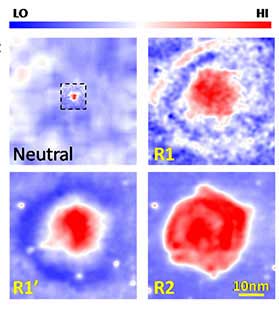| Posted: Apr 20, 2017 |
Creation of artificial atoms in graphene
(Nanowerk News) For the first time, scientists created a tunable artificial atom in graphene. They demonstrated that a vacancy in graphene can be charged in a controllable way such that electrons can be localized to mimic the electron orbitals of an artificial atom.
|
|
Importantly, the trapping mechanism is reversible (turned on and off) and the energy levels can be tuned (Nature Physics, "Realization of a tunable artificial atom at a charged vacancy in graphene").
|
 |
| Starting with a missing atom, referred to as a vacancy (top left), and applying an electric charge that attracts electrons to the region, the electrons are confined into “orbitals” to create an “artificial atom” (lower right). The images are electron concentration maps obtained with scanning tunneling spectroscopy that visualize the vacancy, and then the electron orbitals (in red) of an artificial atom created in graphene. R1, R1’ and R2 show the orbitals in order of increasing energy. (Image: Eva Andrei, Rutgers University)
|
|
The results from this research demonstrate a viable, controllable, and reversible technique to confine electrons in graphene. The energy states of the electrons are 'tunable'. This tunability opens new avenues of research into the unique physics electron behavior in graphene.
|
|
Further, it provides a methodology that could facilitate the use of graphene-based devices for future electronics, communications, and sensors.
|
|
Graphene’s remarkable electronic properties have fueled the vision of developing graphene-based devices to enable lighter, faster and smarter electronics and advanced computing applications.
|
|
But progress towards this goal has been slowed by the inability to confine its charge carriers with applied voltage.
|
|
A team led by researchers from Rutgers University developed a technique to stably host and controllably modify localized charge states in graphene.
|
|
The researchers created vacancies (missing carbon atoms) in the graphene lattice, by bombarding the sample with charged helium atoms (He+ ions).
|
|
They demonstrated that it is possible to deposit a positive charge at the vacancy site and to charge it gradually by applying voltage pulses with a scanning tunneling microscope tip.
|
|
As the charge on the vacancy increases, its interaction with the conduction electrons in graphene undergoes a transition. The interaction turns into a regime where the electrons can be trapped into quasi-bound energy states that resemble an artificial atom.
|
|
The team further showed that the quasi-bound states at the vacancy site are tunable with application of an external electric field. The trapping mechanism can be turned on and off, providing a new paradigm to control and guide electrons in graphene.
|

